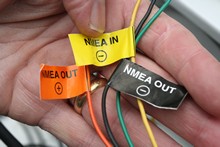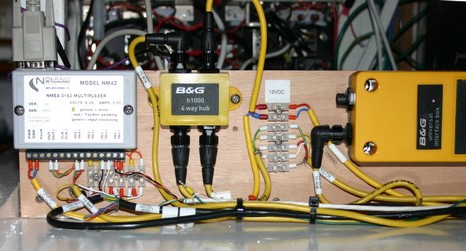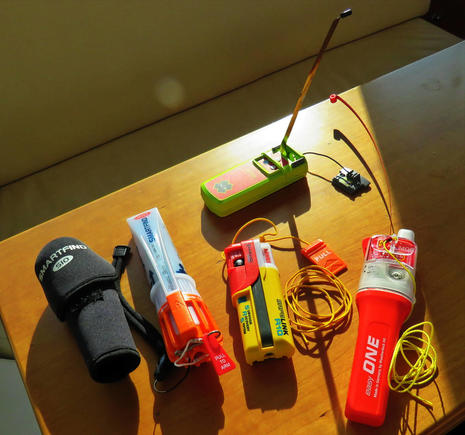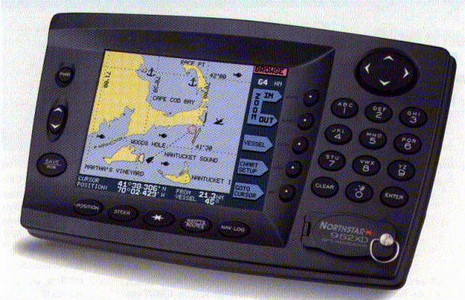NMEA 0183 wiring, why it bugs me

OK, I admit that at least half of the hideous mess above is the fault of yours truly, being sloppy with a temporary install, in this case interfacing a DSC VHF, a GPS, and an AIS receiver all to a Garmin 3210 (possible because it has two 0183 ports, plus a  special Garmin GPS port). But I also blame the standard itself, or non standard really, since there is no common plug, let alone standard wire colors (so you’re delighted to come across nice labelling like Northstar’s at right), or even a uniform nomenclature. Plus the typical bare wires are fine gauge, making them hard to handle and hard to secure strongly. Finally, the variable way the negative side of an 0183 data IN or OUT wire pair works—sometimes wired to its negative OUT/IN opposite, sometimes wired to ground, sometimes not wired to anything—further confuses things, and often means that there’s a partial crossover between the power connection strip (upper left) and the data strip. The photo below, and bigger here, shows how this can all be neatly done, in this case by pros, but it’s still a bit fragile, I think, and it’s going cost you time or money. The chaos and complications of NMEA 0183 wiring make the rugged NMEA 2000 combined data/power cable scheme look very, very good.
special Garmin GPS port). But I also blame the standard itself, or non standard really, since there is no common plug, let alone standard wire colors (so you’re delighted to come across nice labelling like Northstar’s at right), or even a uniform nomenclature. Plus the typical bare wires are fine gauge, making them hard to handle and hard to secure strongly. Finally, the variable way the negative side of an 0183 data IN or OUT wire pair works—sometimes wired to its negative OUT/IN opposite, sometimes wired to ground, sometimes not wired to anything—further confuses things, and often means that there’s a partial crossover between the power connection strip (upper left) and the data strip. The photo below, and bigger here, shows how this can all be neatly done, in this case by pros, but it’s still a bit fragile, I think, and it’s going cost you time or money. The chaos and complications of NMEA 0183 wiring make the rugged NMEA 2000 combined data/power cable scheme look very, very good.













I completely agree with your observations. It is usually not too difficult to connect the (+) phase outputs to the appropriate inputs, but handling the signal grounds or the (-) phase outputs and inputs can be very confusing. I suspect that some manufacturers have provided unbalanced or single-ended outputs yet have marked the signal ground with a (-), implying a differential output and adding to the confusion of how to properly connect them.
When you add other variables to the interconnection, such as baud rate, it can be come even more frustrating.
My current NMEA-0183 interconnections resemble yours, although slightly neater.
NMEA-0183 does specify a baud rate so that should not be a variable. Most of the time you can wire the NMEA (-) to ground on both sides, the transmit and the receive units, that is unless isolation is actually required (NMEA is supposed to be opto isolated.) Then one wire is required from the power strip to the comms strip and you can connect the negitives of all units into it. NMEA 2000 might not be the answer that people think as it is not really widely supported even now, there are still many units without it and of course all the existing units out there. NMEA 0183 will be with us for a long time to come I think.
I am about to rewire our NMEA-0183 system to add a multiplexer for wind instrumentation and future AIS support and am having a bear of a time finding appropriate 4-conductor shielded cable. I have 2-conductor shielded for my NMEA listeners, but I need 4-conductor for the 2-way communicators (computers & VHF Radio) and I can’t seem to find it anywhere anymore. I could go with un-shielded in which case I would probably choose to use CAT-6 UTP cable as at least the twist rates will cut down on interference, but I would prefer a sheilded cable as it runs by the SSB and VHF radio’s. What do you guys use for old school NMEA-0183 systems?
ibsalin-
Pacer Marine stocks two pair cable with an overall shield p/n: M22/2PRF and a two pair cable with each pair individually shielded and an overall shield p/n: M22/2PRIF
Contact Pacer Marine at 941.378.5774 and ask for Bill Ensinger…tell him Charlie sent you!
Charlie
JTB Marine Corp.
http://www.jtbmarine.com
I have worked the commercial marine electronics field for some 30 years and disagree with your argument. Once the professional approach is followed NMEA 0183 is a better system to me. First neatness always is important, not just for looks but the integrity of the connections. Last thing I want is to begin working on a wiring mess like you show and have wires pop off because they are not secured. Second only the toy electronics uses single wire and DC ground, that is just asking for trouble. As for no standard plug or connector, that provides ultimate flexibility in connecting, no plugs to match up or terminators required. The baud rate should be available from the equipment manual, then set accordingly. There usually are only two baud rates used 4800 low speed and 38,400 high speed. A laptop with a simple data reader can check the data, confirm sentences and baud rate. Once there is a problem on the NMEA2000 backbone it can shut down the whole network. Then you must disconnect plugs while keeping the terminations in place until the defective part is found. Or invest in an expensive NMEA2000 meter.